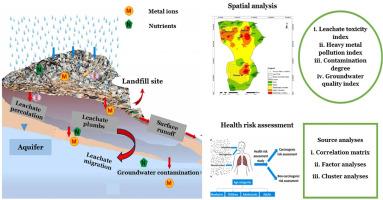利用空间、指数、化学计量和健康风险技术确定尼日利亚在用和已关闭垃圾填埋场渗滤液中潜在有毒元素的特征及其对地下水系统的影响。
IF 8.1
2区 环境科学与生态学
Q1 ENVIRONMENTAL SCIENCES
引用次数: 0
摘要
本研究检测了三个垃圾填埋场(活跃和关闭的垃圾填埋场)沥滤液中的潜在有毒元素(PTEs),以量化和比较其毒性程度以及根据距离分区对含水层地下水的渗滤影响。研究结果表明,活动垃圾填埋场渗滤液的 PTEs 浓度较高(P < 0.05),EC、TDS、Cd、Cu、Fe、Zn、Pb 和 Mn 均高于废水标准限值。沥滤液污染指数证实了活性点的高毒性。地理空间地图显示,含水层受到了沥滤液迁移效应的影响,垃圾填埋场 100 米范围内的地下水超过了监管限值。根据 Ficklin-Caboi 评估,地下水被分为 "低金属-接近中性 "和 "高金属-接近中性 "两类。污染程度、重金属污染指数、地下水质量指数和水污染指数表明,40% 以上的地下水受到 "高度至极度 "污染,不适合饮用,而 50%以上的地下水为 "极度纯净"。地理空间地图显示,垃圾填埋场 100 米范围内的所有地下水都受到了污染,尤其是活动垃圾填埋场附近的地下水。影响地下水质量的主要因素是铅 > 镉 > TDS > 铁 > EC > 铬 > pH > 锰 > 硒 > 钴。相关系数、主成分和聚类分析证实了垃圾填埋场的异质性,以及固体废物主要来自工业、商业和家庭。除了沥滤液的迁移效应,其他人为和地质因素也对含水层系统产生了影响。健康风险评估结果表明,垃圾填埋场周围 100 至 500 米范围内的地下水会对暴露人群造成非致癌和致癌健康风险,其中儿童和 100 米范围内的人群最易受到影响。本文章由计算机程序翻译,如有差异,请以英文原文为准。

Characterization of potentially toxic elements in leachates from active and closed landfills in Nigeria and their effects on groundwater systems using spatial, indexical, chemometric and health risk techniques
This study examines potentially toxic elements (PTEs) in leachates from three landfills (active and closed sites) to quantify and compare their degree of toxicity and percolation effects on aquifer groundwater based on distance zonation. The finding revealed that the active landfill leachates had higher concentrations (P < 0.05) of PTEs, with EC, TDS, Cd, Cu, Fe, Zn, Pb, and Mn being above the standard limits for wastewater. The leachate pollution index confirmed high toxicity of the active sites. The geospatial maps suggest that the aquifer was influenced by leachate migration effects, with the groundwater situated within 100 m of the landfills exceeding the regulatory limits. Based on the Ficklin-Caboi assessment, the groundwaters were categorized into “low metals—near neutral” and “high metals—near neutral." The contamination degree, heavy metal contamination index, groundwater quality index, and water pollution index denote that over 40% of the groundwaters are “highly to extremely” polluted and are unfit for drinking, while over 50% are “excellently pure." The geospatial maps revealed that all the groundwaters within 100 m of the landfills are polluted, especially those near the active landfills. The prevailing factors impairing the quality of groundwater were Pb > Cd > TDS > Fe > EC > Cr > pH > Mn > Se > Co. The correlation coefficients, principal components, and cluster analyses confirmed the heterogeneous nature of the landfills and that the solid wastes were mainly from industrial, commercial, and household sources. Aside from the migration effect of leachates, other anthropogenic and geological factors are influencing the aquifer systems. The health risk assessment showed that the groundwaters within 100–500 m of the landfills are capable of causing noncarcinogenic and cancer health risks in exposed populations, with children and those within the distance of 100 m being the most vulnerable groups.
求助全文
通过发布文献求助,成功后即可免费获取论文全文。
去求助
来源期刊

Chemosphere
环境科学-环境科学
CiteScore
15.80
自引率
8.00%
发文量
4975
审稿时长
3.4 months
期刊介绍:
Chemosphere, being an international multidisciplinary journal, is dedicated to publishing original communications and review articles on chemicals in the environment. The scope covers a wide range of topics, including the identification, quantification, behavior, fate, toxicology, treatment, and remediation of chemicals in the bio-, hydro-, litho-, and atmosphere, ensuring the broad dissemination of research in this field.
 求助内容:
求助内容: 应助结果提醒方式:
应助结果提醒方式:


